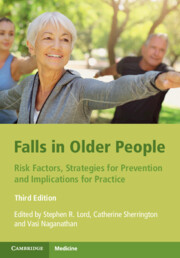Book contents
- Falls in Older People
- Falls in Older People
- Copyright page
- Contents
- Preface
- Contributors
- Part I Epidemiology and Risk Factors for Falls
- Part II Strategies for Prevention
- Part III Implications for Practice
- 28 Strategies to Promote Uptake and Adherence to Fall Prevention Programmes
- 29 Translating Fall Prevention Research into Practice
- 30 Interventions Reduce Falls, but What Is the Cost for Better Health Outcomes?
- 31 Bringing It All Together
- Index
- References
28 - Strategies to Promote Uptake and Adherence to Fall Prevention Programmes
from Part III - Implications for Practice
Published online by Cambridge University Press: 04 November 2021
- Falls in Older People
- Falls in Older People
- Copyright page
- Contents
- Preface
- Contributors
- Part I Epidemiology and Risk Factors for Falls
- Part II Strategies for Prevention
- Part III Implications for Practice
- 28 Strategies to Promote Uptake and Adherence to Fall Prevention Programmes
- 29 Translating Fall Prevention Research into Practice
- 30 Interventions Reduce Falls, but What Is the Cost for Better Health Outcomes?
- 31 Bringing It All Together
- Index
- References
Summary
Despite the strong evidence that many falls are preventable [1], there has been a failure to implement prevention evidence into routine clinical practice across the population of older people. Lack of uptake and adherence to effective fall prevention programmes is well documented. For example, reported participation rates are as low as 6% for balance-promoting activities among older people in Australia [2].
- Type
- Chapter
- Information
- Falls in Older PeopleRisk Factors, Strategies for Prevention and Implications for Practice, pp. 427 - 435Publisher: Cambridge University PressPrint publication year: 2021



